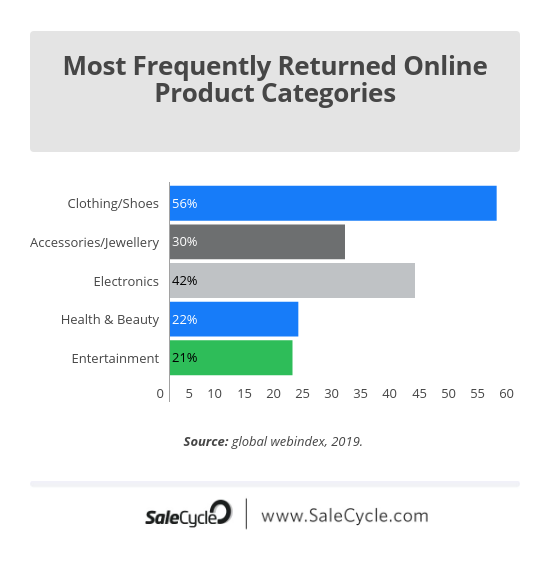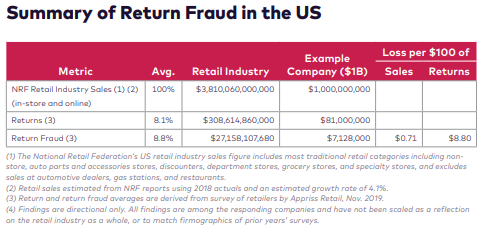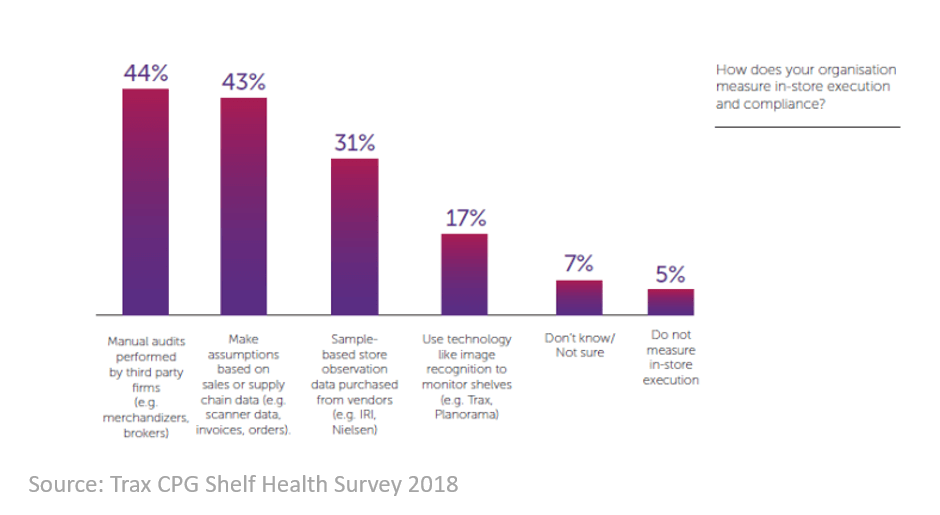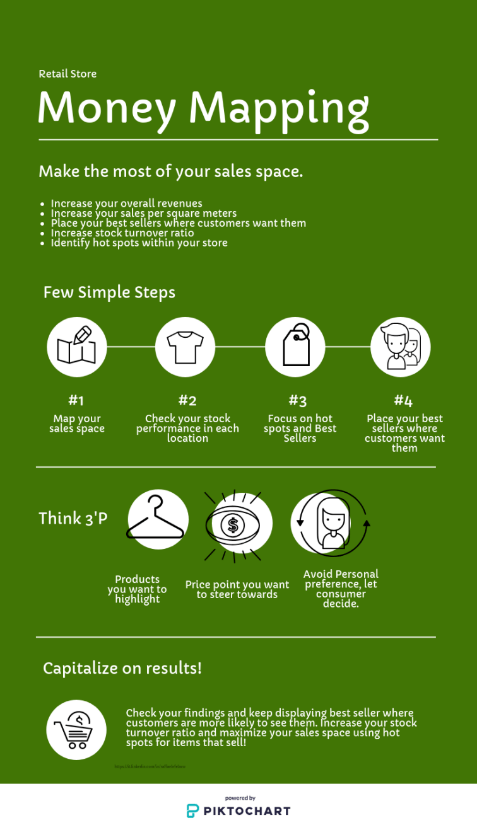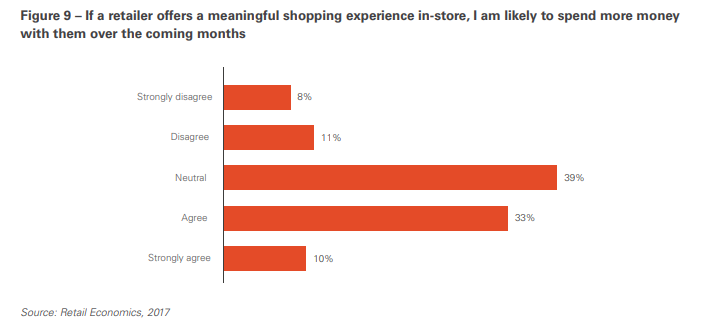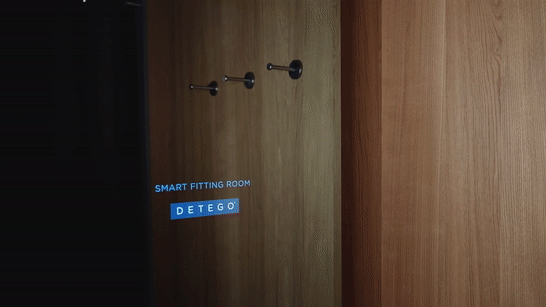Beauty retail is an industry at a crossroads. A sector resilient to crisis and change compared to other retail categories, cosmetic brands are beginning to feel the effects of the pandemic and ongoing industry changes.
In recent years, apparel and sports retailers have undergone digital transformations to stay competitive, and now beauty brands have an opportunity to follow suit. Read this eBook to discover how and why beauty retailing is set to transform into the industry of the future.
Beauty retail: An industry at a Crossroads
The apparel and sports retail industry have undergone mass change over recent years. Such retailers have undertaken digital transformation journeys in their store and distribution networks to adapt to digital-first customers and eCommerce competition. The beauty sector, however, is still behind the curve.
In most major beauty-industry markets, in-store shopping accounted for up to 85 per cent of beauty product purchases before the COVID-19 crisis – (McKinsey&Co) making the level of eCommerce penetration lower than in other retail sectors. While retailers in other categories have been forced to innovate and adapt in the face of falling brick-and-mortar sales, competition from eCommerce and direct-to-consumer models, brick-and-mortar beauty sales were more resilient.
But this is changing. Not only are eCommerce levels steadily increasing year-on-year, but the COVID-19 pandemic has accelerated this drastically, driving five years of change in a single year, according to
IBM. This leaves brick-and-mortar beauty retailers on unsteady ground. Beyond this, brands will have to navigate a more digital-centric environment and optimise margins to cope with reduced sales.
The good news is many of the challenges that are now facing beauty have been facing apparel or CPG for years. The digital solutions and strategies that have allowed apparel to adapt are well established and ready to deploy to the sector. The digital transformations that many apparel and sports retailers were forced to undergo will not only fit beauty retailers but will also help them solve older challenges. Beauty retailers may need to go on a similar journey to apparel, but the tracks are there to follow.
What is in the eBook?
- Beauty retailing at a crossroads
- Bringing beauty operations up-to-speed
- Accuracy redefining margins
- Fixing beauty’s shrinkage problem
- Catching up with the omnichannel trend
- Countering the Gray Market
- Becoming digital and analytics leaders

Discover how retail RFID is changing the industry for good. This eBook will guide you through the top 10 needs identified by retailers to ensure sustainable success in the modern environment. Explore the common challenges preventing retailers from achieving their goals and learn how applying smart RFID-based solutions delivers consistently good results.
What is in the eBook?
The retail industry is currently ruled by change. The digital age has seen a huge growth in competition from e-commerce and a rapid shift in consumer preferences. This shift has altered the industry greatly with modern ‘omnichannel’ customers demanding to shop where they want, how they want and when they want. Delivering such an experience is a challenge, one that requires brick-and-mortar retailers to change.
In this eBook, we analyse the top 10 needs identified by retailers to ensure sustainable success in the modern environment. Within each of these needs, we identify the challenges often preventing retailers from achieving them, and how applying smart RFID-based solutions can deliver consistently good results.
Improving key metrics in stores
- How retailers use RFID for quick and efficient stocktakes and cycle counts
- Improving stock accuracy in stores
- How smart solutions are being put to use for item-level replenishment, ensuring products and sizes are always available to be sold.
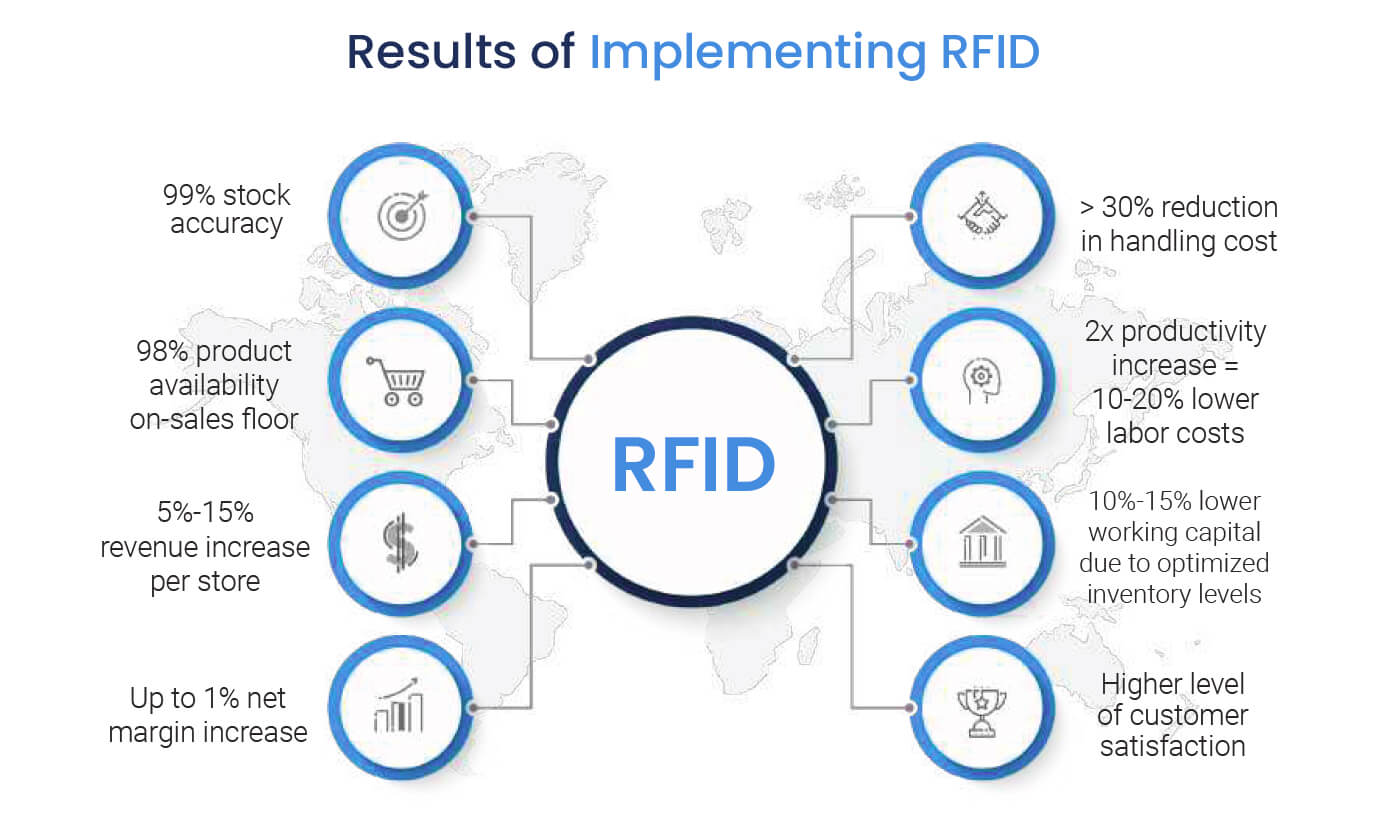
Delivering to customers with retail RFID
- How stores can reduce common customer friction points
- The relationship between RFID and effective omnichannel services
- The advanced retail RFID solutions that improve the in-store customer experience like chatbots and smart fitting rooms.
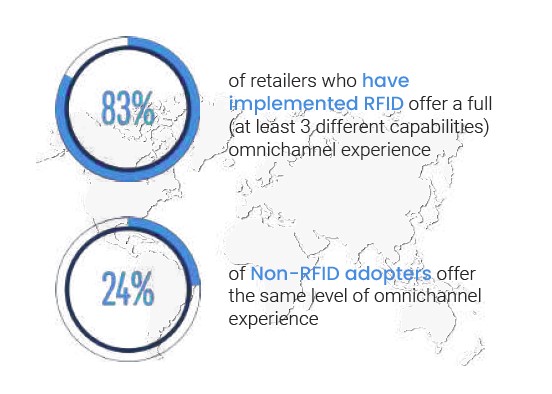
Optimising supply chains from source to store with automated processes
- How to achieve supply chain visibility with real-time info on the movement of products inside and across individual stores and distribution stages.
- How RFID is used to aid logistics at distribution centres, including automated processes like exception handling and order picking.
- What RFID means for retailers’ data and analytics capabilities, such as advanced supply chain traceability and new KPIs for stores and DC’s.
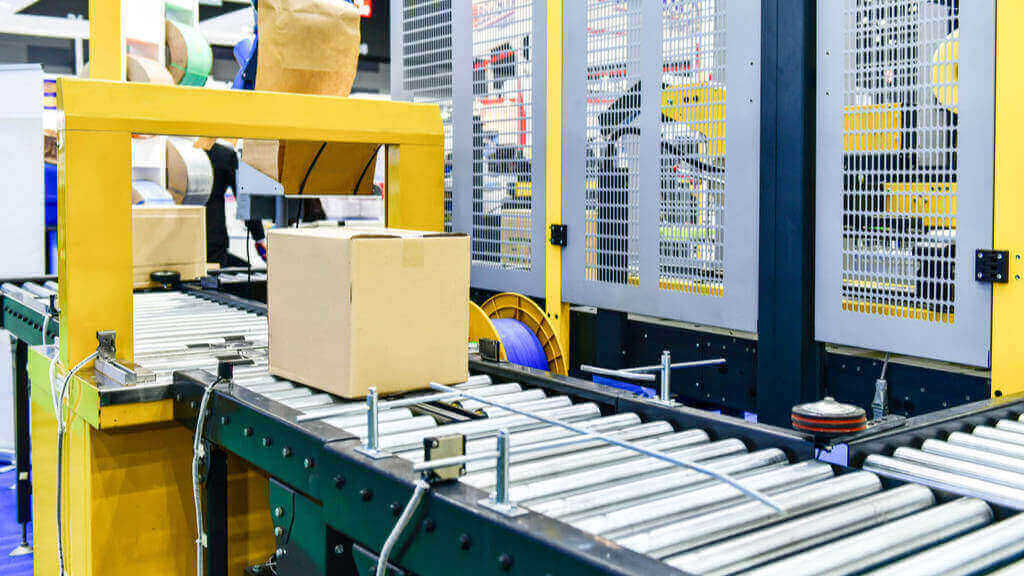
Protecting brands and products from theft, counterfeits and the grey market.
- How RFID can be used to monitor and reduce shrinkage, including theft, both in stores and across the entire supply chain.
- How brands are combatting counterfeit goods by tagging and tracing their products with RFID.
- What the Grey Market means for retail and how several major brands use RFID traceability to locate and stop the source of grey market products.
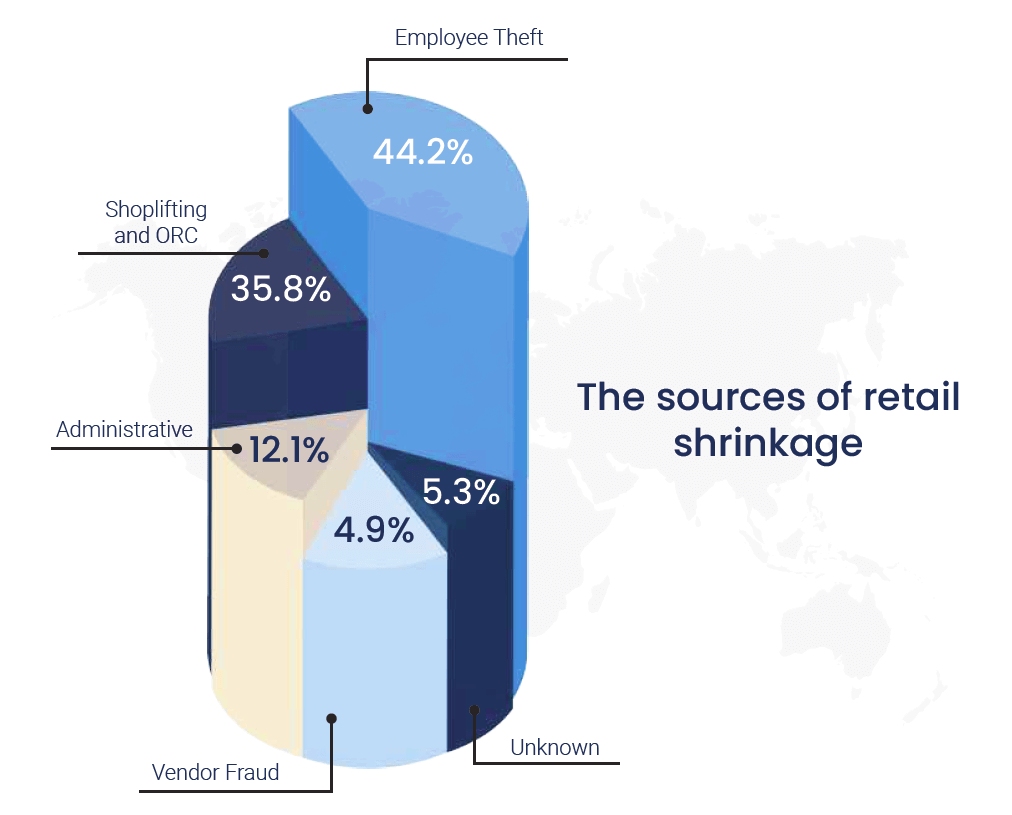
Apparel Retail’s New Normal: COVID-19 Impact and Future Trends
16th June 4 pm BST / 11 am EDT
As apparel retail begins to get back to its feet, how are retailers preparing in the short-term, and what lasting effects will there be? The pandemic will cause the rapid acceleration of ongoing changes in the industry, and entirely new ones that could never have been expected.
Now stores are facing new social distancing guidelines, the formula for customer experience has changed. With reduced foot traffic and higher levels of eCommerce, the digital evolution of the retail store is now or never. Join us on the 16th of June as we dive into the physical and digital transformations behind retail’s ‘new normal’.
This webinar will cover:
- The impact of the COVID-19 crisis on the apparel retail industry
- How retailers are adapting retail stores to social distancing measures
- How a shift in the balance between eCommerce and brick-and-mortar is driving retailers to adopt digital-enabled stores
- How retailers can utilise digital and analytics to optimise operations and solve key challenges
Data by nature: Why eCommerce analytics are steps ahead
Online retailing not only created a new way of shopping, but it also changed the game when it comes to tracking and analysing the shopping journey. There is almost nothing that is not being evaluated while surfing the webshop. Digital-heat-maps of individual online sessions are analysed, showing every click and scroll through the online store. Every possible KPI is monitored: Conversion rate, click-through rate, average order value, the relation between new and returning visitors, bounce rate and retention to name a few. The really powerful thing about this is that analysis is always followed by action, to improve both the effectiveness of the webshop and the experience of its customers.
Data by design? Time for brick and mortar to take some lessons
Naturally, eCommerce has a significant advantage when it comes to analytics, a digital channel is always going to produce more data. Brick-and-mortar stores need to adapt to compete however, and technology is trying to bridge this gap between the physical and digital. Some of the more hardware-heavy options include AI-powered cameras, smart shelves or even aisle-roaming robots.
While hardware-intensive solutions like customer-tracking smart cameras are available, with the right software supporting it, a technology that simply tracks products (such as RFID) and leverages the IoT (Internet of Things) can revolutionise analytics for stores. These technologies and their supporting platforms are a big driver of ‘Digital transformation’ which delivers the analytics and data that brick-and-mortar stores are desperate for.
Here are 3 lessons from eCommerce for improving analytics in retail stores….
The need for real-time data
For years, brick-and-mortar retailers have been complaining about imprecise stock-figures and unreliable historical data. Unhappy with its purchasing decisions based on last year’s sales figures, retailers would prefer to have real-time data and inventories that allow for reliable and economically viable decisions. After all, it is important to avoid high-security stocks in order to reduce capital tie-up.
But why do we actually have this problem? Are the data points offered by the ERP systems not enough? Unfortunately not – it is not unusual that the ERP system shows higher stock than actually available on the sales floor. This so-called “ghost stock” is the cause for various problems in sales, e.g. the ERP system says a certain article, for example, a red skirt in size S, is in stock, but in reality, it is not. It can neither be sold nor refilled from the central warehouse – a classical out-of-stock situation. Or vice-versa, the ERP displays a lower inventory level than is actually available. The reason for these deviations is insufficient accuracy in individual processes that dangerously sum up over time.
Today’s intelligent article management is based on three pillars: fast, RFID-based article identification on item-level, tracking of every movement in real-time and proactive analysis with concrete recommendations for actions to take for the sales personnel. This is the foundation for optimum customer service and efficient processes.
What does real-time data mean for Brick and Mortar Stores?
- High Stock accuracy
- Increases product availability of the shop floor from accurate replenishment
- Allows for convenient omnichannel services like click-and-collect
- Equips store staff with up-to-the-minute stock information – allowing them to assist customers better
Meaningful KPIs in the store
When measuring KPIs, the practical benefits for retailers are paramount. Three areas of data in the store can be distinguished:
KPIs for Store performance
Inventory Accuracy
Whether five or 800 stores, KPIs for measuring inventory accuracy are significant for every retailer and still represent one of the main challenges in today’s business. Retailers, on average, can actually make accurate statements on just about 75% of their inventory (based on SKU level). However, this is not enough to meet customers’ expectations for omnichannel services. Therefore, inventory transparency and corresponding KPIs are essential for retailers´ success.
Product availability
Product availability on the sales floor, also known as on-floor availability, is the second central parameter. Initially, it is less about the exact position and more about the fact that the articles are on the sales floor – after all, only items that are actually available can be sold. This key figure can be combined with an alert system that makes sure not to fall short of the defined minimum availability. Complementary to classical ERP-systems, RFID-based merchandise management takes the data granularity to the next level, by knowing exactly at each moment in time if products are really on the salesfloor or still lingering in the backroom of a store.
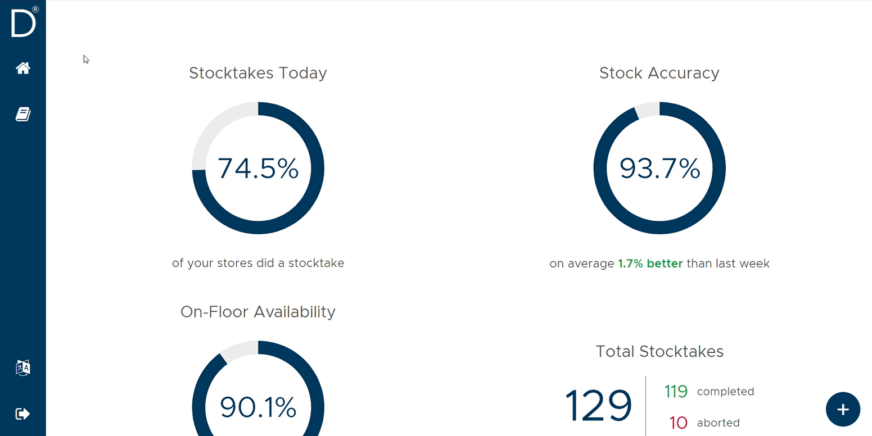
KPIs for individual product & campaign performance
Product dwell-time on salesfloor
Having data on item level, store managers are also given important information on the dwell times of articles on the sales floor. This information is more valuable than simple sales data, as it tells us the average time individual products spend on the sales floor before being sold. This can be used to gauge whether products are performing & corresponding with the sales plan. Common recommendations made from this data include moving items do a different location on the salesfloor (i.e. adjusting the planogram) or relocating excess inventory to another store – both of these measures reduce profit-sapping inventory bloat and end-of-season markdowns.
Fitting room conversion rate
One of the most famous KPIs in e-commerce is the conversion rate that describes the ratio between purchases and website visitors and also provides information on certain items that were already in the shopping cart, but for some reason have not been purchased in the end. Specifically, this aspect was incredibly difficult to measure in the store for a long time but can now be measured in fitting rooms using IoT and RFID technologies. This provides meaningful insights into how many, and above all, which articles does a customer take into the fitting room and which one does she/he actually buy?
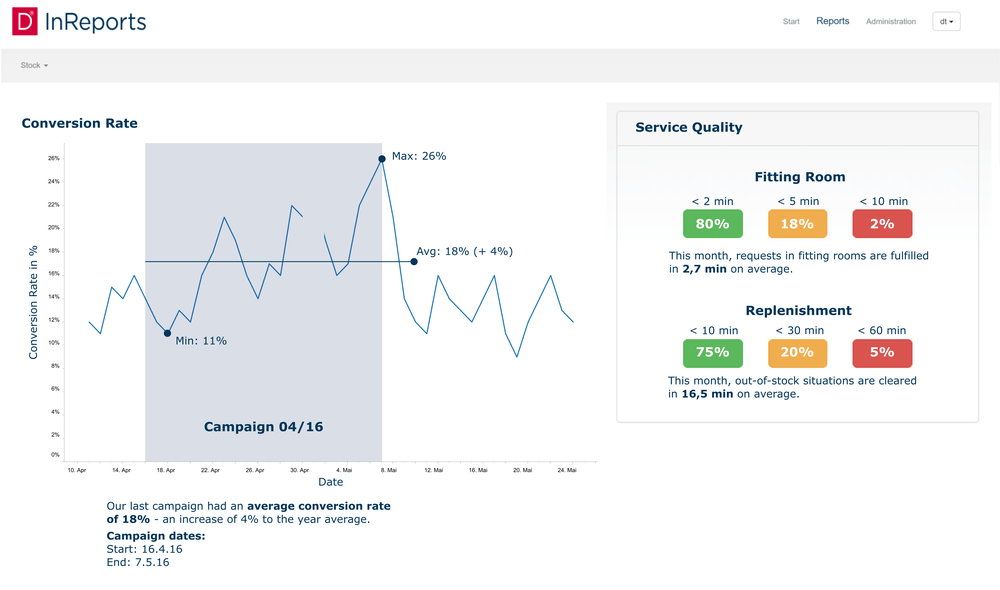
KPIs on customer engagement and service quality
On an operational side, KPIs can also be used to manage service quality. We’ve already covered product-availability and stock accuracy, which affect the customer just as much as the store with out-of-stocks or unavailable sizes being all-too-common pain points. The replenishment rate provides another angle to combat this, as it shows how quickly articles are replenished on the sales floor. On the other hand, the fitting room response time describes how quickly sales personnel handle customer requests coming from the fitting room. The KPI “Conversion rate per campaign” shows the success of a campaign and if campaign-specific countermeasures are necessary.
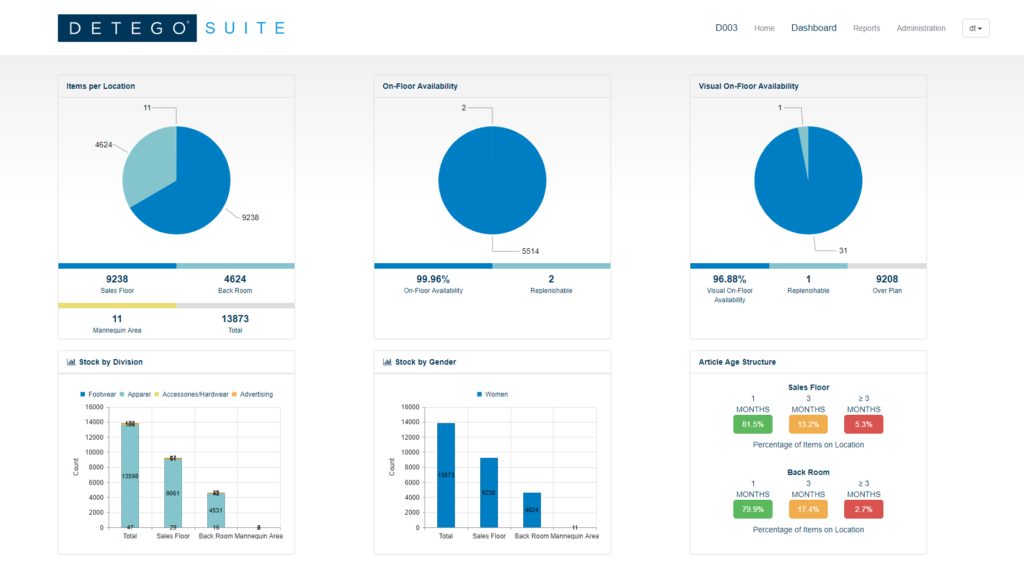
Turning data into actions
The final lesson brick-and-mortar retail should learn from the webshop? Turning data into actions. Since nobody needs a data graveyard, any analysis needs the goal of creating immediate actions to improve. Today’s systems help the management team as well as the store personnel with concrete and automated recommendations for actions to take. This saves time in the decision-making process, unburdens the sales personnel, and enables them to do the right things at the right time.
KPIs should be suitable for everyday business use. Presented visually and self-explanatory, they need to be linked to clear recommendations for actions to take. This frees up store personnel time and provides a data-driven way of optimization. Examples range from simple in-store replenishment advice, i.e. “The minimum stock for article #47699-0010 has been reached – please refill three pieces” to more advanced topics, e.g. to choose a different placement in the store for a specific article when the dwell time on the sales floor is too high compared to other stores. Advanced systems can even utilise AI and Machine learning to automate and refine certain processes, like adjusting store planograms and creating optimal pick paths when replenishing stock.
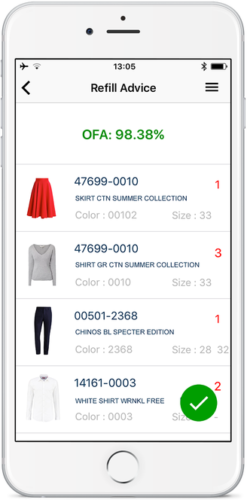
Conclusion
Brick-and-mortar retail needs support and an update to the toolbox when it comes to analysis and measures. Not only does the sales personnel benefit from intelligent recommendations for action, but the management team also gains efficient control mechanisms across the entire store network. Decisions are made based on real-time data and therefore allow timely action. Ultimately, the end customer is pleased about a first-class service, which – thanks to the individual and informed advice through the sales personnel – even exceeds the standards of the online retail.
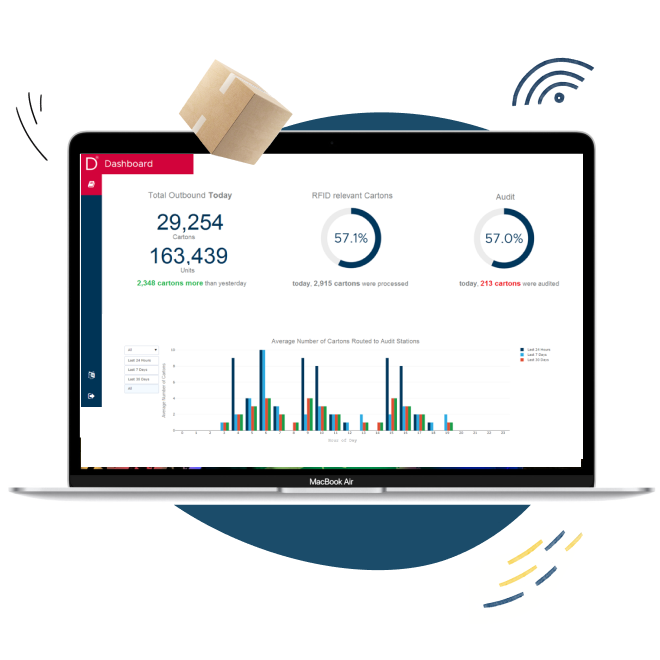
Webinar
Item-level Reporting from
Source-to-Store
Register for this webinar where we outline the impact of digitisation on supply chain analytics and operational efficiency. Covering the wealth of item-level data unlocked by RFID, the presentation will explain the new KPI’s available for modern supply chains and their impact on retail operations.
Online returns have been a challenge for retailers since the beginning of eCommerce. This is because of both their volume compared to normal stores, and the costs associated with processing them. In the wake of COVID-19, this problem could prove more critical then ever, as online becomes retailers’ singular sales channel. There is already early evidence of this, with preliminary data from Quantum Metric showing that eCommerce associated with Brick and Mortar retailers saw an average revenue weekly growth rate increase of 52%, and Nike Inc.’s digital sales went up by 36%.
The eCommerce returns dilemma
Online shopping is popular for a reason, but the convenience and choice of eCommerce comes at the price of not being able to ‘try before you buy’ for customers.
This simple difference is the reason online returns are so much more prevalent than for Brick and Mortar stores. In eCommerce the customers’ homes becomes the fitting room. And, just like any fitting room, products end up back on the shelves. According to Happy Returns, while shoppers return only 10% of what they buy in stores, they send back up to 50% of what they buy online.
This is compounded by customers accounting for this when ordering online. A survey from Barclays found that 30% of shoppers deliberately over-purchase and subsequently return unwanted items. Additionally, 20% regularly order multiple versions (often sizes) of the same item so they could make their mind up when they are delivered, all of which is facilitated by the retailer at great cost.
While it might seem logical to have stricter returns policies, or make customers cover the cost of returns, consumer expectations make this a risky strategy. According to the 2017 UPS Pulse of the Online Shopper survey, 68% of shoppers view returns policies before making a purchase. This leaves retailers with a catch-22 situation when it comes to losing out on online sales or losing profits from processing the inevitable returns that comes with those sales.
What are the challenges of retail returns?
So why are returns such a strain on retailers?
Cost of returns – First and foremost is the simple cost of returns. Since returns are in themselves essentially lost sales, the added cost of returning them, which according to CNBC is on average 30% of the purchase price, can heavily impact retailer’s margins.
Processing returns and reverse logistics – On top of this is the resources and effort of processing returns and getting the stock back available to be sold as quickly as possible. This reverse logistics can be particularly challenging and can result in returned stock not being available for purchase again for some time, often leading to out-of-stocks on the webshop. According to the Barclays report, 57% of retailers say that dealing with returns has a negative impact on the day-to-day running of their business.
Contamination concerns with COVID-19? – A unique and recent challenge, particularly for apparel retailers, is dealing with the potential contamination and contact of returned good with the COVID-19 virus. Initial research suggests that the virus can only survive on fabric surfaces for 24 hours, but for up to 72 on plastics like packaging. This will need to be addressed by eCommerce retailers who continue trading throughout the epidemic.
Return fraud – This is a challenge shared by brick-and-mortar stores. Fraudulent returns cost the US alone 27 billion dollars a year. This can involve the ‘returning’ of stolen merchandise for cash, stealing receipts to enable a false return or using someone else’s receipt to return unpurchased store stock. Naturally, using receipts for returns presents a risk, APPRISS found that receipted returns are more than twice as likely to be fraudulent as other methods.
How to reduce the impact of returns on eCommerce
So what options are there for retailers looking to tackle their returns problems?
- Reduce the likelihood of returns, without harming customer experience or sales: Include accurate and detailed product descriptions. Use uniformed/standard sizes where possible and provide a more specific sizing filter. Offer virtual ‘try-ons’ with augmented reality/3D imaging.
- Set clear and accessible rules regarding returns: Make sure customers know what and how they are allowed to return items, this reduces spending resources processing illegitimate returns.
- Improve visibility: Maintain a single view of stock with item-level inbound and outbound processes, this will also allow for online returns back to stores, and ship-from-store. Make this visibility accessible to your entire team and your customers.
- Improve efficiency of inbound and outbound processes: Utilise reliable & efficient technologies and automated processes like exception handling. One of the leading technologies for this is RFID, which prevents the need to open any boxes or packages as it can count and verify items without direct line of sight.
- Improve internal processes: Ensure returns processes (and supporting software) enables additional layers of merchandise management such as grading items based on quality and tracking when the item was returned.
- Counter Return Fraud: Verify legitimacy of returns as much as possible, best practise involves unique item-level validation like RFID or unique serial numbers.
- Ensure returned stock is safe to sell: Implement processes to ensure returns are not damaged in any way, implement a policy to account for safe handling of merchandise during theCovid-19 pandemic, either sanitising products or leaving them a set amount of time before adding back into webshop stock.
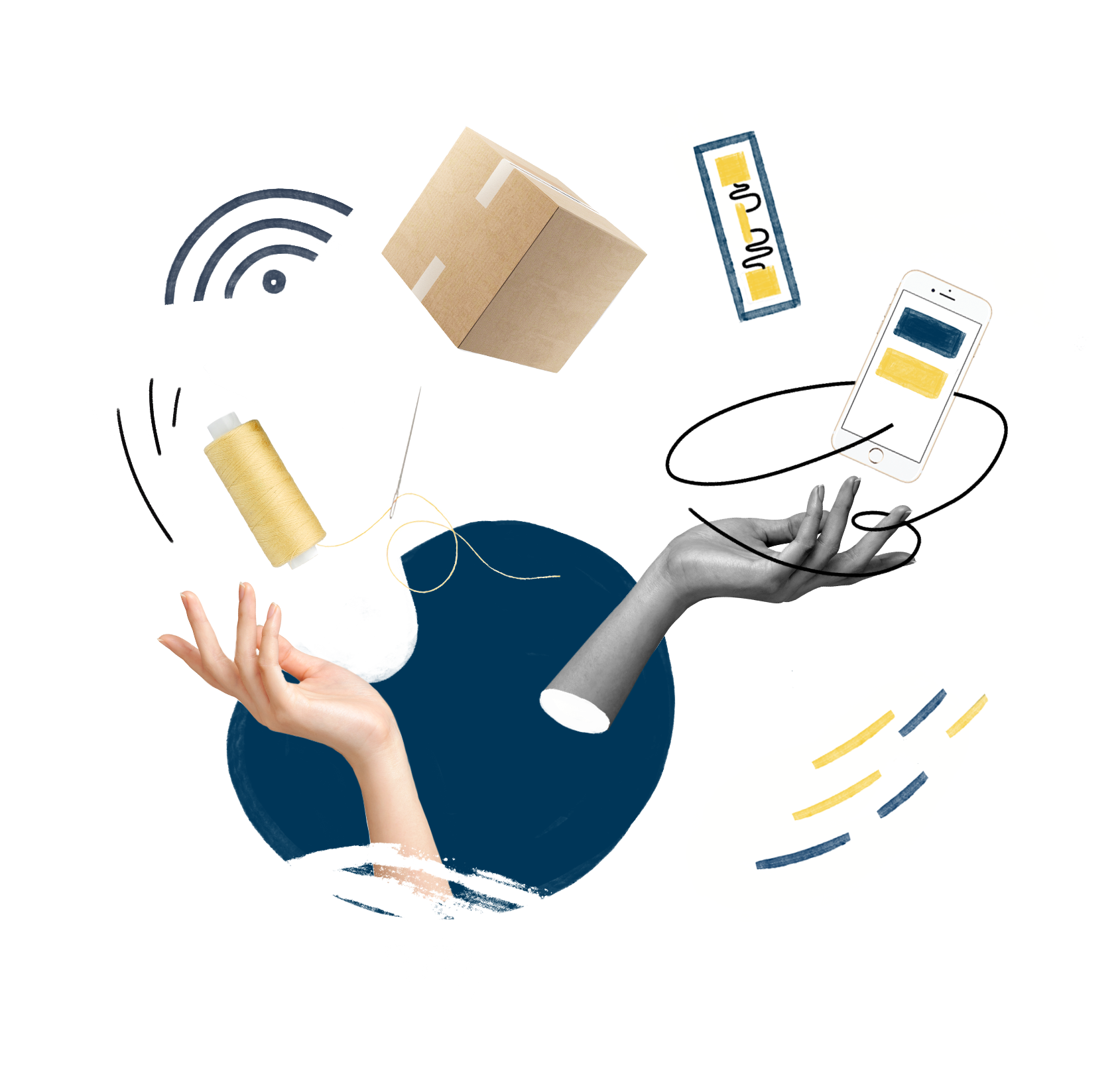
Using RFID tagging and looking to improve return processes?
NEW: eCommerce returns module
eCommerce/ DTC is increasing due to COVID-19. This causes an over proportional increase in returns which normally would require a ramp up of staff and equipment to handle the process – Detego’s new RFID enabled return process provides an approx 90% productivity increase.
Want the latest retail and retail tech insights directly to your inbox?
Visual Merchandising’s Data Problem
Visual merchandising is one of the ‘dark arts’ of retail. For the uninitiated, it’s the practice of designing visually appealing sales floors and store fixtures that attract customers and ultimately sell the products on display. It’s a subjective and artistic means of delivering a concrete KPI – sales.
One of the challenges of visual merchandising is data, experimentation & design is all well and good, but not if you have no way of knowing what does and doesn’t work. Sales data is always a good place to start, but there are so many other factors at play that it’s often unwise to attribute visual merchandising to an increase or decrease of sales to a single product. You have to go one step further…
What is Money Mapping?
So, how do you measure the sales performance of a store based on its layout and design?
First, you map out the sales floor with the exact location of products. Then you break the map of the store into ‘zones’, typically around certain fixtures, shelves and displays. These zones can consist of several different items, grouped by either category or style depending on the design of the store.
You then collate the sales of every item in this zone and compare it to others in the same store. The result? An impression of shop floor sales broken down by areas of the store.
This is called ‘Money Mapping’ and allows retailers to visualise and analyse which areas of a store are ‘hotspots’ and which are ‘cold’ in terms of sales. This gives an initial view of which areas and fixtures are selling products and which aren’t.
To account for other external influences on sales, best practise is to swap items between fixtures or observe a ‘money map’ over a long time, as collections and merchandise changes between seasons. This way, if the localised sales data remains relatively similar even after products have rotated, then it’s clear the design or locations of the fixture is having an impact.
What are the benefits of Money Mapping?
- Insight on consumer experience
- Provides valuable data for visual merchandisers
- Breaks down areas of sales floor by sales performance
- Can be used to optimise store layout
- Drives Sales
- Can compare Product Placement & Visual Merchandising
- Can be used to conduct A/B tests
This all sounds great, so why doesn’t every retailer and every store do this already? The simple answer – the process of matching the sales data to specific locations on the sales floor, manually for every item and every store, is logistically a big ask. This means, if this can be done at all by visual merchandisers, it can only be done in a small number of stores.
How does AI change money mapping?
So how can we solve this data problem for visual merchandisers and make ‘Money Mapping’ easier and more accessible for retailers?
The first issue is having an accurate map of a store which includes exactly where every single item is sold from. Traditionally this would have to be done manually, and then have the sales data of items cross-referenced with their location in a store.
The solution: Using RFID (Radio Frequency Identification) and AI localisation techniques, we can now create a map of a store as part of the daily or weekly stock count.
This is done by adding ‘reference’ RFID tags into the store. Small tags just like ones that go on products are placed on fixtures and walls in the store. Because these never move, we can use the signal strength (relative to the fixtures) from stock counts to map exactly where items are in the store and what items they are grouped with.
This location info is then integrated with data from point of sale to generate an automated Money Map of a store, as part of the regular reporting and analytics function of the store. This can be done for as many stores as desired. With the data collection automated, visual merchandisers can focus on using the data to optimise product placement and store design across stores.
With larger data sets to work with, this also opens up the potential for more detailed analysis and experimentation such as A/B testing product combinations and store layouts!
What’s the process for AI Money Mapping?
- Attach reference RFID tags to walls and fixtures within the store
- Perform regular RFID stock takes as normal
- Software uses machine learning to ‘map’ out item locations within the store
- Integrate point of sale data with RFID software
- Software produces ‘heat map’ of the store based on sales
- Visual merchandisers can use data to inform strategy and measure results
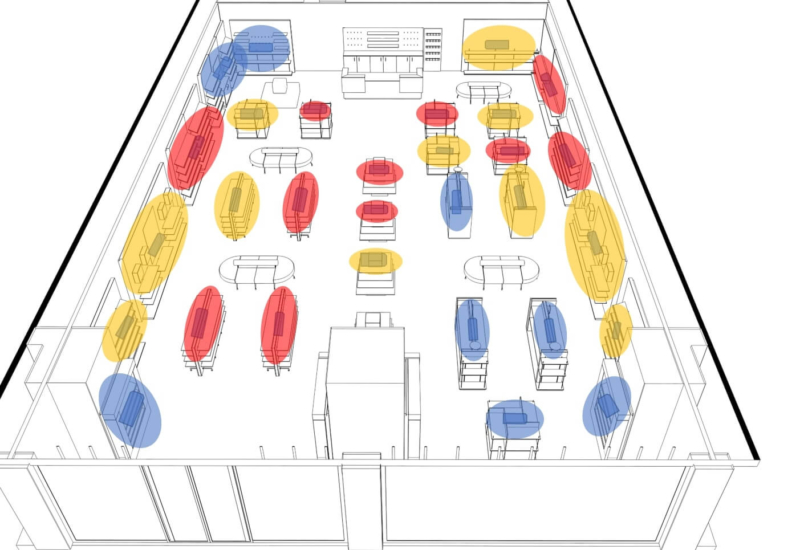
Conclusion
Visual merchandising is a subtle but valuable process for retailers. Done properly it has a huge impact on both sales, customer experience and brand image. The only problem with this is visual merchandisers often don’t have enough data to measure performance and identify where their attention is needed most. The data they can collect is either time consuming, expensive or inaccurate.
Artificial intelligence changes the game for visual merchandising. By utilising RFID tags and Machine Learning, it is possible to ‘map out’ the location of items in a store, and more importantly, the sales distribution of the shop floor. These ‘Money Maps’ tell visual merchandisers what areas of the sales floor are ‘hotspots’ for sales and which are underperforming. Using this data, they can then focus their attention on improving the design or layout of certain areas.
Additionally, with this data stores can look to leverage their sales hotspots either by prioritising the best locations for best-sellers, high-value items or items that are due to go out of season.
Either way, AI-enabled Money Mapping is another important evolution in retail data and analytics. Providing retailers with unprecedented insight into exactly what goes on in Brick and Mortar Stores.
Want the latest retail and retail tech insights directly to your inbox?
What is a Smart Fitting Room?
Smart fitting rooms consist of an interactive touch-screen mirror connected to an RFID reader and a motion sensor. They sense when customers enter the fitting room, and sense what items they have brought in with them by reading their RFID tags. They then assist the customer throughout the fitting room process, giving them information on products and calling for assistance if required. In simple terms, they allow consumers to experience the same benefits they get from online shopping whilst in the fitting room, as well as let them request items be brought directly to them.
What does a Smart fitting room do?
- Detect movement and presence of a customer
- Identifies which item the customer brings to try on
- Displays additional product information
- Provides availability information to the consumer
- Shows product recommendations that would complement the currently selected style
- Provides additional services such as Call for Assistance or Call for different products / colors / sizes
Smart fitting rooms have existed in the fringes of the retail technology space for a number of years. The interactive mirrors certainly capture the imagination, but they’ve only really existed at trade shows and in concept stores rather than out in the wild. It’s fair to say the technology was in the category of interesting and fun but not really taken seriously. Fast forward to 2020, and we have just seen the first major commercial use of smart fitting rooms, in a truly digital, experience-first, award-winning store.
What makes up a Smart Fitting Room?
- Framed Mirror
- RFID Reader & Antennas
- Motion Sensor
- Touchscreen Display
- Internet Connection
- A store that is using RFID item-level tagging
So, now is the time to start paying attention to Smart Fitting Rooms. But for those looking at the technology, either for the first time or with fresh interest now that solutions are live in the market, the business case might be a concern. In this article, we will break down exactly what a smart fitting can do, and what kind of value they offer for retailers, customers and retail profits.
What are the business benefits of Smart Fitting Rooms?
Improving Customer Experience
As a customer-facing technology, we’ll start with the most obvious (yet qualitative) use of the smart fitting room – an improved customer experience.
Rather than taking this for granted, however, let’s dig into how, why and even if smart fitting rooms offer a better experience for customers. Having a mirror automatically detect and display item information is nice and will wow customers (at least to begin with) but doesn’t really add much more value than an interactive screen that can scan products barcodes or even a product QR code.
What sets smart fitting rooms apart from these solutions are the interactive options and how they support customers. This includes offering additional and related or ‘frequently bought together’ items, information on exactly what is available in the store (using the real-time stock view RFID provides) as well as being able to request items be brought directly to the fitting room. These options being built directly into the mirror that customers already use will both delight customers and make the fitting room experience more convenient.
How smart fitting rooms benefit the customer:
- Shows different product combinations
- Makes product recommendations
- Article availability check
- Shows full range of articles to browse through
- Additional information, videos, social media integration
- Customer-friendly fitting (Article-Bring-Service)
- Enables digitally supported purchase decisions
- Direct reservation or ordering of articles
- Different delivery options (delivery to home address, from another store, etc.)
The economic value of customer experience:
Increase Sales
‘Customer experience is king’ has been a favourite tagline of innovative retail for some time. While it’s probably true and certainly sounds good, when it comes to the business case of new technologies you really do need to look at revenue. In terms of the customer, that generally means sales. So, what effect do smart fitting rooms have on sales? Other than more tenuous effects like bringing more customers in to the store, Smart fitting rooms increase retail sales in two ways:
Combating Lost Sales
Fitting room conversions is a self-explanatory if unfamiliar term for brick and mortar stores. That’s because as a KPI retailers have never had any way to measure or track this (more on this later). But fitting rooms are absolutely pivotal to apparel sales.
According to The Retail Doctor, shoppers who use dressing rooms are 70% more likely to buy versus those who don’t. It’s easy to see why, as customers have already decided that they like the item and want to purchase it, so fitting rooms become a question of making sure, and finding the right size.
It’s finding the correct size where most fitting rooms sales are lost. If a customer needs a different size, they will have to leave the fitting room and come back. Studies prove that this can have a major impact on sales, as 50% and 21% of people say they will sometimes and every time respectively leave the fitting room and the store if they were looking for assistance to change colour or size of an item and can’t find anyone.
This is why helpful fitting rooms assistants have such a big impact on sales, customers who receive assistance in fitting rooms make twice as many purchases as those who don’t. Smart fitting rooms address this issue, showing customers what other sizes are available and letting them request different sizes be brought directly to them. This allows stores to have assistance on hand (they are notified via a mobile application) without needing a permanent fitting rooms assistant, which is not feasible for many stores.
Increasing basket size with in-store cross-selling
The other sales driver of smart fitting rooms is having product recommendations made based on the items brought into the fitting room. This brings cross-selling common in e-commerce to the brick and mortar experience. Whilst these can be done as an endless aisle (so the entire product range of a store) the better way is to only offer items that are available in the store (using the stock visibility RFID provides). Much like requesting additional sizes, customers can request to have items that catch their eye brought directly to them. This can drive sales significantly and has been seen to increase fitting rooms basket size by 100% in initial studies.
New Data and Insights For Stores
The lesser-known use case of smart fitting rooms is the data and insight provided about the customer experience. It’s often said that compared to e-commerce, retailers have next to no data about what actually happens inside their stores. Other than what gets sold, they’re blind. In an industry as competitive and fast-moving as retail, this lack of analytics can be fatal.
We’ve already established how important fitting rooms are to apparel sales, so it seems that collecting and analysing data from them is a no-brainer. Traditionally however this hasn’t been the case, but with RFID and smart fitting rooms, retailers can collect that data in a non-invasive way.
What kind of insights are provided by smart fitting rooms?
- Item Conversion rate – How often are items selling (or not selling) immediately after being tried on in a fitting room?
- Fitting baskets vs shopping baskets – Most tried on vs most sold
- Number of items per session
- Session duration
- Recommendation conversion rate – How often are items recommended, requested and then sold?
- Need assistance use – How often are staff called to the fitting room using the mirror?
- Staff response time – How long does it take for store staff to react to customer requests? (gaining actionable insight to customer experience)
Conclusion
Consider the context of interactive displays, AR, VR and even RFID tables. Smart fitting rooms are both a part of this space and completely apart from it. This is because fitting rooms aren’t new, they are and always will be a part of the apparel shopping experience. Rather than adding a new element to the shopping experience like VR for example, smart fitting rooms are improving an integral (and for many, unpleasant) part of the customer experience.
In other words – it’s an evolution, not a revolution.
Whether retailers embrace this evolution will be decided in the coming years, now that smart fitting rooms are finally out in the wild. Perhaps even more crucially, especially when talking about business case, now smart fitting rooms are out in the market we will begin to see data and results that will prove the value once and for all. As early innovators of the technology, we can’t wait.
Want the latest retail and retail tech insights directly to your inbox?
In the modern retail industry, you’ll no doubt read a lot about how ‘customer experience is king’, but with such a subjective notion that can’t be measured in any reliable fashion, it often feels like a vague concept. An actively bad experience is more tangible (and something we described how to avoid in our previous article) but what makes an exceptional one is more of a grey area. In fact, the elusive notion of customer experience is at risk of becoming yet another retail buzzword.
So, what does good customer experience look like? We’ll start with making an important distinction between shopping and buying. Shopping is the all-round experience of browsing in a store, looking at items, trying them on (in the case of apparel) and finding items and making decisions as you go. Buying on the over hand is a more straight forward (in theory) process were a customer knows what they want to buy, or at least has a rough idea, and finds and purchases their item quickly and easily.
It’s often said that E-commerce is ahead of physical retail when it comes to simply buying but struggles to match the shopping experience of brick-and-mortar. Some retailers have leaned into what sets them apart from online, focusing their investment and new technologies on improving the shopping experience, to surprise and delight their customers. Others have looked to implement technology to compete with e-commerce’s convenience and provide a more streamlined and ‘seamless experience’.
The reality is both of these elements are pivotal to a strong customer experience, and retailers should look to improve both, sticking to the principal that:
Retail should be fun when you want it to be, but fast when you don’t.
Fun retail
The fun side of retail is mostly concerned with the shopping side of the retail experience. This is obviously very subjective, and many retail customers will simply find the traditional shopping experience fun, provided they are not hampered any problematic friction points. For other customers though, more needs to be done to amplify the ‘wow factor’, as Steve Dennis says, to tempt them away from either a competitor or the convenience of online.
Retailers are increasingly looking to technology to boost consumer engagement in the store and provide a more entertaining shopping experience. Examples of this include:
Augmented reality
Augmented reality (or AR) is an interactive experience where virtual images are placed over images of the real world. Applications of AR in retail include mobile applications and fitting rooms where consumers can virtually try on products like clothes or even cosmetic products.
Smart Fitting Rooms
Smart fitting rooms offer a considerable improvement on the traditional fitting room experience and bring a little bit of the online experience into the brick-and-mortar store. The mirror automatically detects items (when tagged with RFID) that have been brought into the room, displays them on the mirror with product information and suggests other items that are available, effectively bringing cross-selling into the store.
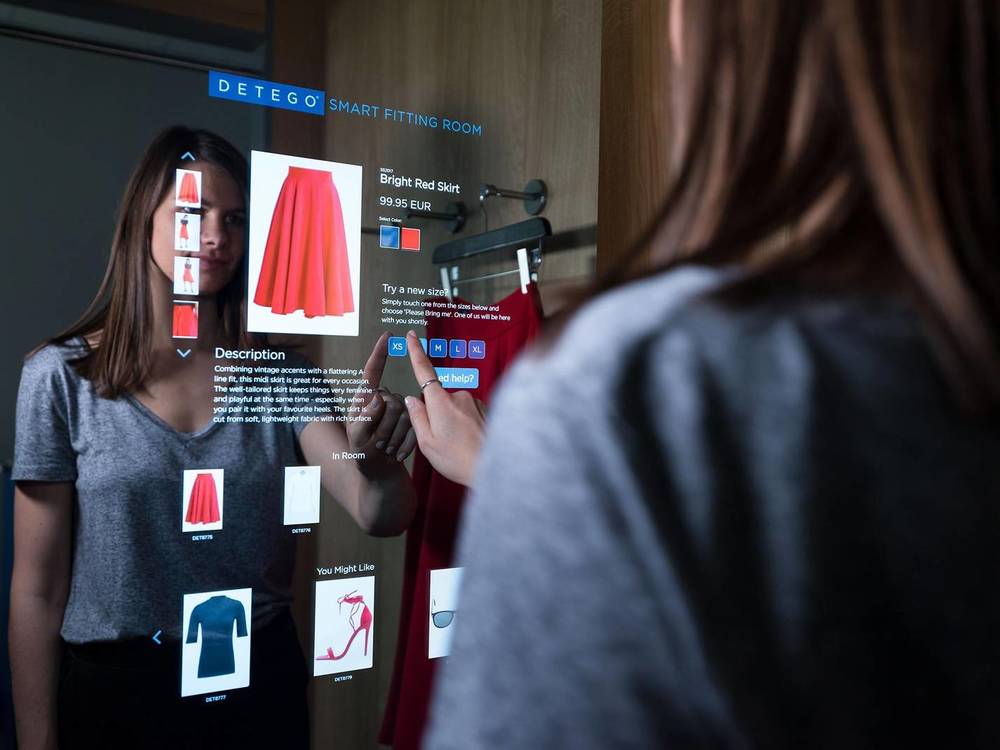
Virtual & Robotic store assistants
Robotic store assistants are certainly on the more futuristic end of the spectrum, with the ability to talk to customers and guide them around the store. Whilst this technology is in the earlier stages, with fairly low adoption rates, they are an undeniably fun concept that will make customers think ‘wow’. On the other end of the spectrum we have virtual assistants or chatbots, which can communicate with customers through their smartphones and answer queries and provide them with information about items and stock-levels.
Fast retail
But what happens when a customer doesn’t want to spend their time on the full shopping experience? In such a case, a customer is only focused on buying and not shopping. Certain retailers leave something to be desired here, with disorganised stores and long lines for customer service and checkouts. The buying side of retail also happens to be what e-commerce excels at, so retailers need to invest in technology to be able to compete and keep customers choosing their stores when it comes to fast and convenient purchases. These technologies and strategies include:
Advanced Points of Sale
Long lines for checkouts are a common problem in retail, and for customers looking for a fast experience this is a major friction point. Thankfully there are a range of PoS technologies that make checkout fast and frictionless. Self-checkout is very common in the food industry and reduces queues if not the time taken at the checkout itself. Alternatives like RFID PoS on the other hand significantly reduces checkout times, were as checkout-less solutions like Amazon go and Mishipay remove the checkout altogether.
RFID’s smart inventory
The other main thing slowing down the buying process in the brick-and-mortar experience is finding the correct item in the first place. Locating a specific item in the store can sometimes take far more time that it should, especially if staff don’t have the time or the information to help. What’s even worse than this is if after searching for the item the customer finds out that its out-of-stock altogether. We explored this in detail in our previous article but RFID not only significantly reduces out-of-stocks and increases on-floor product availability, but the real-time view of inventory it provides means customers can check available stock online before setting foot in the store.
Omnichannel services
We’ve spoken about e-commerce being good at the buying half of retail, and with the vast majority of retailers now being online and 73% of customers using multiple channels in their shopping journeys, it’s no surprise the demand for omnichannel is as strong as it is today. For a fast retail experience, customers can take advantage of click-and-collect and click-and-reserve when they just want to buy products rather than shop for them.
Good customer experience does both
So, to wrap things up, if retailers want to establish a reputation for a great customer experience, they need to have an equal focus on the shopping experience and the buying experience. Shopping should be fun; the in-store offering should be superior to online and at its best it should surprise and delight customers with a certain ‘wow factor’. At the same time, sometimes people just want to buy, and if brick-and-mortar stores make that significantly less convenient than online then they’ll suffer to the competition. By effectively leveraging the right technologies retailers can provide a top-level customer experience that delivers on all fronts and keeps customers coming back time and time again.
The UK’s first completely Cashier-less grocery store
The British supermarket Sainsbury’s has recently announced the end of its cashier-less store trial, concluding that ‘it’s clear that not all our customers are ready for a totally till-free store.’
The initiative involved the UK’s first till-free grocery store, utilising a mobile app with smartshop scan, a pay & go technology where customers can scan items with their mobile’s cameras as they move through the store.
Whilst there is huge potential in this technology which Sainsbury’s are trailblazing for, the trial did certainly have some initial setbacks. The pilot store experienced long lines at the help kiosk, due to many customers wanting to pay with cards and cash.
In response to this, Sainsbury’s have added a manned till and two traditional self-checkout tills to support the store’s mobile payments. Whilst this does mean the concept of a completely cashier-less store has been shelved for now, the mobile-scan option was clearly a sucess, with Sainsbury’s adding the payment option to eight additional stores.
Convenience isn’t one-size-fits-all
The first thing this technology-project highlights is the necessity of piloting new solutions before rolling them out on a larger scale. Sainsbury’s not only got this right, but they clearly paid attention to their customers during their pilot.
Whilst it’s possible Sainsbury’s were partly-motivated about the possibility of totally cashier-less stores (and the operational benefits those would bring), they rightly put their customers first and acknowledged an important truth: Convenience isn’t one-size-fits-all.
Improving customer experience is typically one of the main targets for technology investments in the retail industry. But doing this effectively is often about giving the customer more options, rather than just replacing the existing ones with something more modern and innovative.
Ultimately, solutions like this are designed to make shopping faster (One half of a strong customer experience). However, if you take options away from customers, especially ones they will naturally expect to have, you can slow the experience down and inadvertently add a friction point to your store.
Key Takeaways:
- When releasing new technologies, piloting the solution first in a small number of stores is crucial.
- When evaluating the success of pilots, it’s important to be unbiased and measure the full range of impact of the technology – This includes qualitative results as well as the regular measurable statistics.
- When improving customer experience, technology should look to give customers more options rather than replace existing ones that they may have grown to expect.
The 6 Key Benefits of RFID in Retail
RFID (Radio Frequency Identification) uses radio waves to track and identify tags attached to objects. The tags contain electronically stored information and are counted or ‘read’ by either handheld or fixed RFID readers.
In many ways RFID is used in retail as an alternative to a barcode system (although it doesn’t have to replace barcodes entirely). The more advanced technology involved in RFID mean it has a far greater level of accuracy and efficiency when it comes to counting inventory. As a result of this it has far broader applications in retail, most of which are built of off the back of this reliable inventory visibility.
By implementing RFID retailers can on average increase their revenue from 5-15% depending on the business. This on top of a margin increase of up to 1% and 10-15% lower working capital due to optimised inventory levels.
According to research in 2018, 69% of retailers cite a significant level of adoption, and this number is continuing to rise.
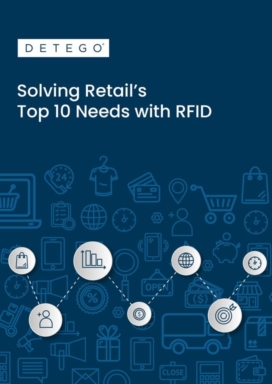
eBook
Solving Retail's Top 10 Needs with RFID
Discover how retail RFID is changing the industry for good. This eBook will guide you through the top 10 needs identified by retailers to ensure sustainable success in the modern environment. Explore the common challenges preventing retailers from achieving their goals and learn how applying smart RFID-based solutions delivers consistently good results.
Inventory Visibility

Due to the ease and accuracy of RFID stock counts, retailers using the technology can reliably achieve full item-level inventory visibility across their stores and supply chains. Crucially, due to the speed of RFID inventory counts, this can be achieved whilst actively reducing the labour intensity of operational processes. This accurate and up-to-the-minute inventory information is the backbone of so many of RFID’s uses in retail (including many of the points discussed below).
One crucial aspect of modern retail that relies on having accurate inventory visibility is Omnichannel retailing. With a complete and up-to-date view of stock across all channels, it is possible to open up the inventory of your entire store network to customers, providing a better customer experience and increasing sales.
Benefits of item-level inventory visibility
- Improved shipping accuracy
- Excellent baseline for advanced omnichannel retailing
- Produces more data for better insights
- Reduces inventory size (and therefore working capital) significantly
- Increased customer satisfaction from reduced out-of-stocks and a more connected experience
Increasing Product Availability

Ensuring a high product availability is vital to maintaining retail sales. Despite this, low on-floor product availability and out-of-stocks are an alarmingly common problem in the industry, causing unnecessary lost sales as a result of inefficient replenishment processes and stock inaccuracy. This latter cause is practically removed completely by RFID, with typical stock accuracy being increased to 99% from the standard 60-80%.
Additionally, RFID platforms provide an unbeatable basis for efficient and reliable replenishment processes. The main advantage these platforms have is the item-level and real-time inventory visibility gained from regular 99% accuracy stock counts.
How does RFID increase product availability?
- Makes regular cycle counts possible with efficient RFID stock reads
- Removes stock inaccuracy (from 70-80% to 99%)
- Creates complete item-level view of stock between both backroom and sales floor
- Item visibility makes replenishment easier and more accurate
- Real-time view allows for replenishment alerts for when items/sizes are running low
- Item-level data from RFID allows for advanced, even AI-assisted planograms for individual stores
Supply Chain Traceability

We’ve discussed the difference item-level visibility makes for stores, but when it comes to supply chains the benefits are just as great. With RFID, inbound and outbound reads become far easier, and are done on an individual item level rather than SKU (stock keeping unit). This means each item is accounted for at each step of the supply chain, rather than just shipments or boxes.
This level of stock visibility also drastically reduces the rate of shipping errors or picking mistakes as they are detected by RFID readers and corrected by warehouse staff during exception handling or outbound reads.
Additionally, the location or status of items and shipments are visible in real-time, so stores and DC’s can easily track shipments and know exactly what they will be receiving. This makes any individual item fully traceable, as time and dates of when the item passed each read point in the supply process can be stored.
Benefits of RFID in the supply chain:
- Item-level visibility across entire supply chain
- Trace items against individual shipments
- Smoother operational processes
- Track shipments for delivery
- 100% inbound and outbound shipping accuracy
Increasing Process Efficiency

The difference in process efficiency from using RFID in retail is extensive, at every end of retail, be it the factory or the shop floor. An RFID reader, regardless of whether its fixed or a handheld, can read hundreds of individual items at once. Crucially though, as each item has a unique ID, they can never be read more than once. The signals also do not require line of sight to be read.
Naturally, this makes RFID inventory counts and inbound/outbound checks incredibly fast and reliable. In the case of store inventories, RFID has been found to reduce cycle count times by a staggering 96%. This therefore means they are far more convenient to perform and can be done multiple times in a week rather than a year.
Processes transformed by RFID:
- Cycle counts/inventories
- Fast & Efficient Inbound & Outbound reads
- RFID-enabled picking and packing
- Mobile guided replenishment from backroom to salesfloor
Providing Real-Time Data

Analytics and data is one area that e-commerce is ahead of physical retail. This is largely due to the fact that everything online can be measured, whereas retailers don’t really know what’s happening with their stores and customers in any specific detail, and the stats and data they do collect are often historical and at risk of being outdated.
However, with RFID this can all change. The simplest and most effective use of the data allows retailers to better leverage their greatest assets; their products and their stores. Quality data and analytics can allow retailers to ensure merchandise is in the right place to be sold. Information on which stores are performing better or worse is a basic retail KPI, but with specific item data, RFID produces far more detailed insights. This includes how well individual items are doing in specific stores, right down to specifics such as which sizes of items are selling better where. Insights such as these are naturally actionable, meaning retailers can take steps to move or reinforce stock at specific stores.
Data insights and results possible with RFID:
- KPI based performance tracking
- Detailed merchandise data & Analytics
- Operational excellence
- Actionable recommendations
- Compliance tracking
- Eliminates reliance on historical data
- Predictive capabilities for inventory counts and merchandise management
Transforming Customer Experience

There are many effects of RFID in retail that go beyond simple operational benefits to actively improve the customer experience. At the most basic level, this includes things already mentioned like increasing product availability, offering convenient omnichannel services and freeing up store associates to spend more time assisting customers.
However, because of the real-time inventory visibility it provides, RFID can go way beyond this in terms of improving the customer experience. For example, with reliable and up-to-the-minute stock information stores can utilise technologies like chatbots or smart fitting rooms to assist customers with their queries, supply information about other items or sizes available and even cross-sell to customers in the store.
What ways does RFID improve the customer experience?
- High product availability
- Store associates have more time for their customers
- Convenient omnichannel services
- A connected experience between online and offline
- AI-powered chatbots delivering assistance and product information via mobile.
- Smart fitting rooms providing a hugely improved fitting room experience.
- RFID-enabled Point of Sale – including self-checkout services

eBook
Solving Retail's Top 10 Needs with RFID
Discover how retail RFID is changing the industry for good. This eBook will guide you through the top 10 needs identified by retailers to ensure sustainable success in the modern environment. Explore the common challenges preventing retailers from achieving their goals and learn how applying smart RFID-based solutions delivers consistently good results.

